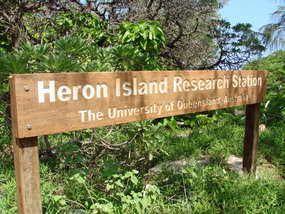Die Inhalte dieser Seite sind leider nicht auf Deutsch verfügbar.
Seitenpfad:
- Graduate School GLOMAR
- PhD student reports
- Research Placements
- Wiebke Krämer
Wiebke Krämer
Report of GLOMAR PhD student Wiebke Krämer about her research stay at Heron Island Research Station (HIRS) and University of Technology Sydney (UTS), Australia from 24 June - 15 August 2010
My main reason for my research stay at the Heron Island Research Station (HIRS) and at the University of Technology in Australia was to collaborate in a research project with Prof. Dr. Peter Ralph. He is one of the leading scientists in the photophysiology of tropical primary producers (mainly corals and seagrasses).During my research stay at HIRS, several experiments on coral photophysiology were conducted with scientists from UTS, especially with the Australian PhD student Verena Schrameyer, in order to explore the stress physiology of Symbiodinium sp. and the holobiont under high-light conditions. In addition, the influence of heterotrophic feeding of corals on their performance was examined. The research questions were addressed both as tank experiments and as one in situ experiment.
Heron Island Research Station is part of the Faculty of Science, University of Queensland and is located in the Southern Great Barrier Reef, 80 km offshore from Gladstone. The facility includes several well-equipped labs and aquaria infrastructure and is an internationally renowned facility for coral reef research. Hence, my research stay at HIRS represented the unique opportunity to address my research questions in an optimal surrounding with direct access to the natural coral reef environment and, in particular, in a highly productive cooperation with experts.
After spending four weeks at HIRS, I stayed for another month in the Aquatic Processes Group, within The Plant Functional Biology and Climate Change Cluster (C3) at the UTS to complete the analyses of the samples taken during the period at HIRS. In addition, I extensively worked together on the data with Verena. The results were discussed with Dr. Ross Hill and Prof. Dr. Peter Ralph. Furthermore, I was able to establish contacts and friendships with other scientists in the field of photophysiology.
In summary, during my research stay abroad I was able to collect important data for my PhD thesis. Furthermore, I greatly benefited by cooperating with the department of Prof Dr. Peter Ralph by establishing new contacts and by acquiring expertise of inestimable value in the field of zooxanthellae and coral physiology. In a nutshell, the time in Australia was very inspiring and valuable for me. Therefore, I would like to thank GLOMAR for the funding and for providing me with this opportunity.
Heron Island Research Station is part of the Faculty of Science, University of Queensland and is located in the Southern Great Barrier Reef, 80 km offshore from Gladstone. The facility includes several well-equipped labs and aquaria infrastructure and is an internationally renowned facility for coral reef research. Hence, my research stay at HIRS represented the unique opportunity to address my research questions in an optimal surrounding with direct access to the natural coral reef environment and, in particular, in a highly productive cooperation with experts.
After spending four weeks at HIRS, I stayed for another month in the Aquatic Processes Group, within The Plant Functional Biology and Climate Change Cluster (C3) at the UTS to complete the analyses of the samples taken during the period at HIRS. In addition, I extensively worked together on the data with Verena. The results were discussed with Dr. Ross Hill and Prof. Dr. Peter Ralph. Furthermore, I was able to establish contacts and friendships with other scientists in the field of photophysiology.
In summary, during my research stay abroad I was able to collect important data for my PhD thesis. Furthermore, I greatly benefited by cooperating with the department of Prof Dr. Peter Ralph by establishing new contacts and by acquiring expertise of inestimable value in the field of zooxanthellae and coral physiology. In a nutshell, the time in Australia was very inspiring and valuable for me. Therefore, I would like to thank GLOMAR for the funding and for providing me with this opportunity.



